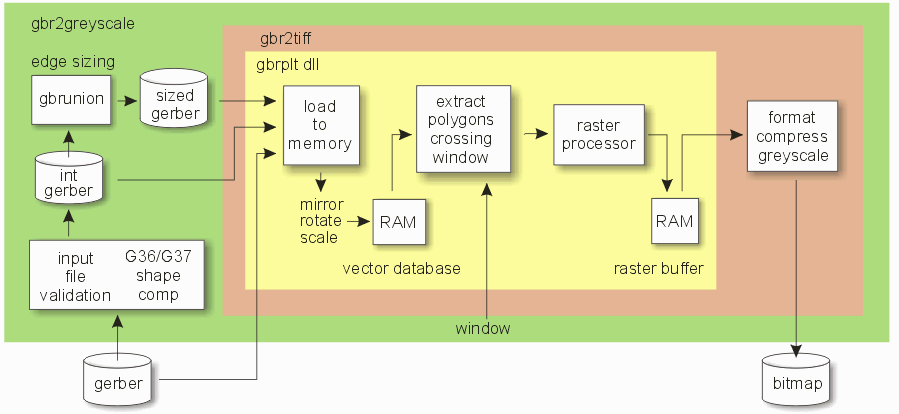

GBR2GREYSCALE is a raster image processor designed to convert the Gerber photo plotter format (RS274X) into a greyscale TIFF bitmap for use by image writers and machine vision and inspection equipment (AOI). It is similar to Artwork's GBR_RIP but includes several special features that are not a part of GBR_RIP.

These include:
Edge Offset - placing a finite sized pixel on the "edge" of a line can result in wider lines than intended (and narrower gaps.) The Edge offset (-shrink) parameter allows a user to enter an offset distance to account for finite pixel diameter.
Grey Levels - Some imaging systems can support full 255 levels of gray - however many can't take advantage of that many levels. GBR2GREYSCALE has a special bitmap output that has 2 levels of gray between black and white. Of course, if desired, thresholding can be turned off to get the full 16, 64 or 256 levels of gray.
Dithering - As an alternative to gray scale, the output bitmap can be dithered to achieve similar effects with a monochrome bitmap.
Tile size and overlap - the user can define the size of the output tiles and an amount of fixed overlap. Fixed overlap is very helpful for architectures that double expose the stitched regions between photo heads.
GBR2GREYSCALE is available as either an executable (controlled by a command line interface) or as a library in DLL format. This gives OEMs who wish to integrate the RIP into their own software maximum flexibility.
The gbr2greyscale RIP executable is controlled by a command line using the following syntax:
gbr2greyscale.exe
<input>
-outname:<outbasename>
-outdir:<outdirectory>
-workdir:<workingdirectory>
[additional arguments]
[Additional Arguments]
======= Bitmap Options ===================
-bmp Output BMP file format
-pack Output TIFF Packbits file
-tiff Output uncompressed TIFF file
-inverse Inverse output polarity
-no_header Remove output header
-dpi:<dblval> Dots per inch (default: 1024)
-dpm:<dblval> Dots per mm
====== Sizing, Scaling, Options ==========
-scale:X[,Y] Scale along X and Y (values can be different to achieve different DPI for each axis)
-shrink:<dblval> Edge Shrink value (default: 0.0)
-unit:<inch|mm> argument units (default: inch)
====== Windowning Controls ===============
-window:<LLx,LLy,URx,URy> Window extent
-aw:<left,right,bottom,top> auto extents w. user specified margins
====== Program Control Options ==========
-silent Disable popup messages
-keeptmp Keep temporary files
-dirtydata[: 1 | 2 ] Process as if input is ill conditioned. (can be set via ACS_DIRTYDATA environment variable)
-thrnum:N number of concurrent threads
-ram:<intval> Buffer Size MB (default: 256)
-warning Output Gerber Union warnings to log file
-scanonly returns data extents into a window
-bandsize:<w>,<h> Band(tile) width and height in pixels
-bandoverlap:<x>,<y> Band(tile) overlap in pixels
-gbrargs: < > arguments passed directly to the Gerber Union engine
-thrnum:<intval> number of concurrent threads for the sizing engine
overrides value on gbr2greyscale thrnum argument.
-ripargs: < > arguments passed directly to the RIP engine
-thrnum:<intval> number of concurrent threads for the RIP
limited to max of 4
-tiffargs: < > arguments passed directly to the tiff formatter
-erraswarn When set, dropped polygons will not cause the program
to fail.
-nowarn This option excludes conditioning warning (warning
messages from our split274x call) messages in the
log file. Errors will still appear in the log file.
-norip Does not create any RIP output and reports the image
info in the log file.
========== Geometry Controls ===========================
-chord_error:<dblval> Chord error value
-circularize:<dblval> after Boolean, recover arcs using
the value supplied as the tolerance.
-rotate:<dblval> Rotate
-mirror:<x|y> Mirror output
-margin:value Rip margin
-scale:value Rip scale
========= Preprocessing Controls =======================
-nosplit suppresses both input file validation and
G36/G37 shape compensation.
-nosplitshrink performs input file validation but suppresses
G36/G37 shape compensation.
-conditioning_retry:<num> enables multiple passes of polygon "fixing" at the
front end for especially "dirty" input data such as those
with multiple vertices at the same coordinate. Do not use
unless needed. A reasonable starting value for <num> = 2.
======= Greyscale Controls ==============================
-super:<2|4|8|16> Super Sampling (default: 0)
-threshold:<intval,intval,intval> Values in percent (grey scale)
====== Dither Controls ===================================
-dither[2|4|8]<:comma separted list of table values>